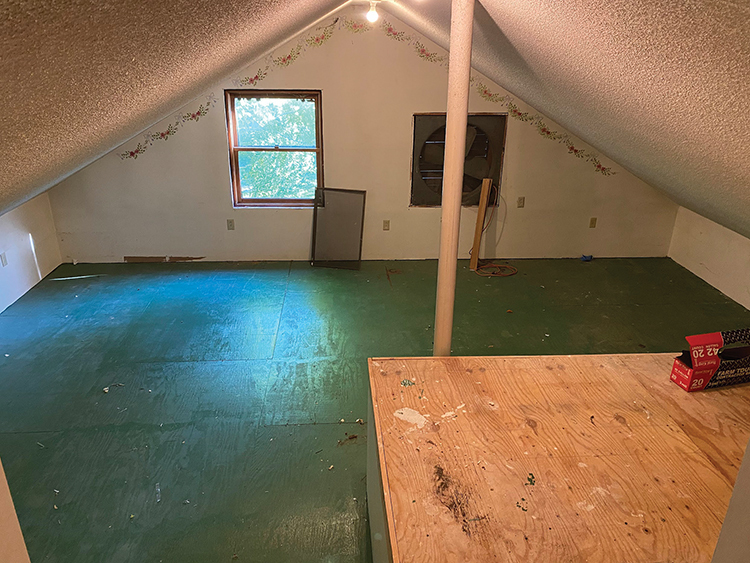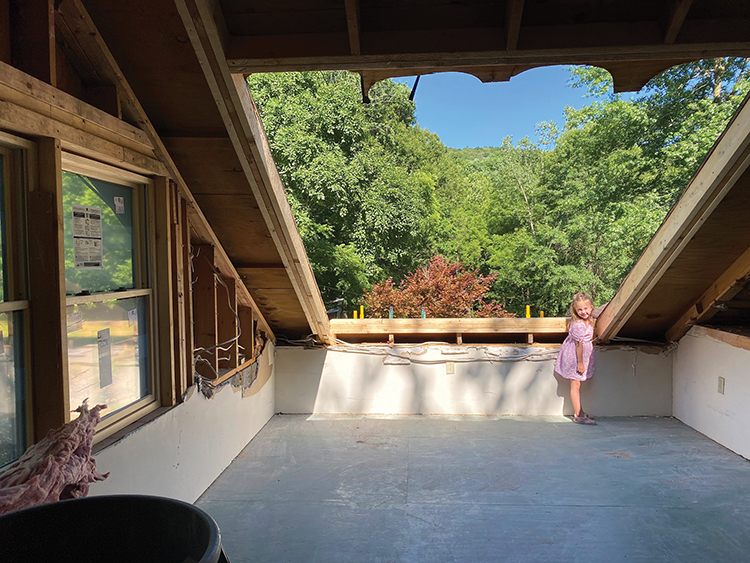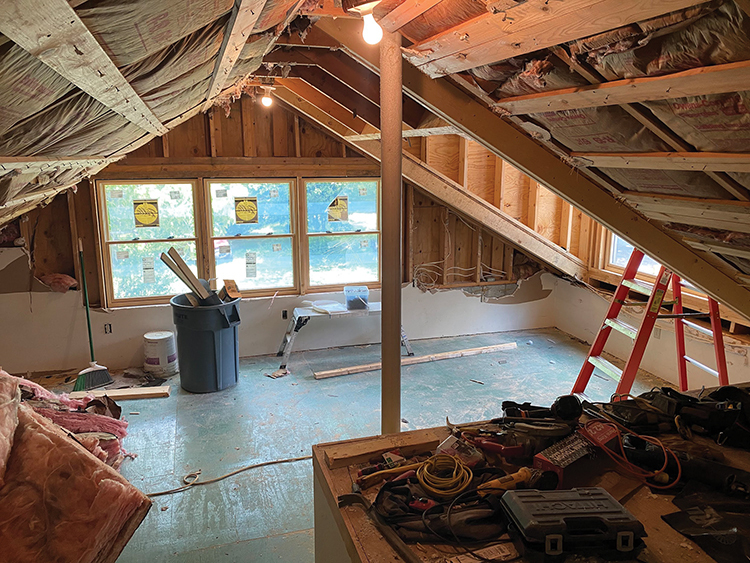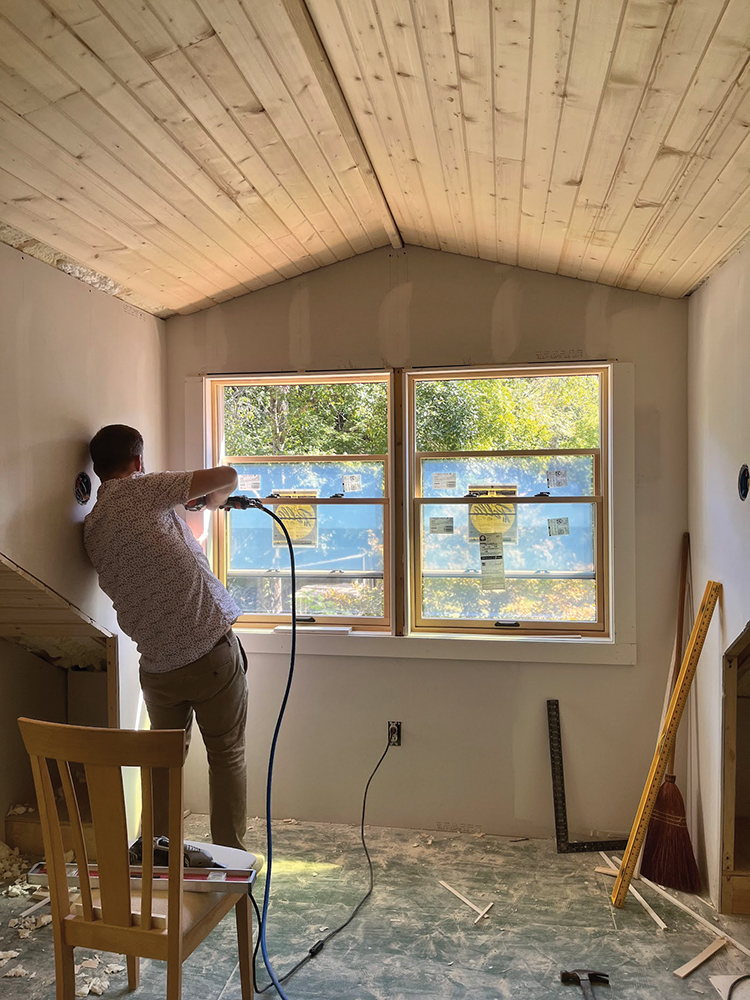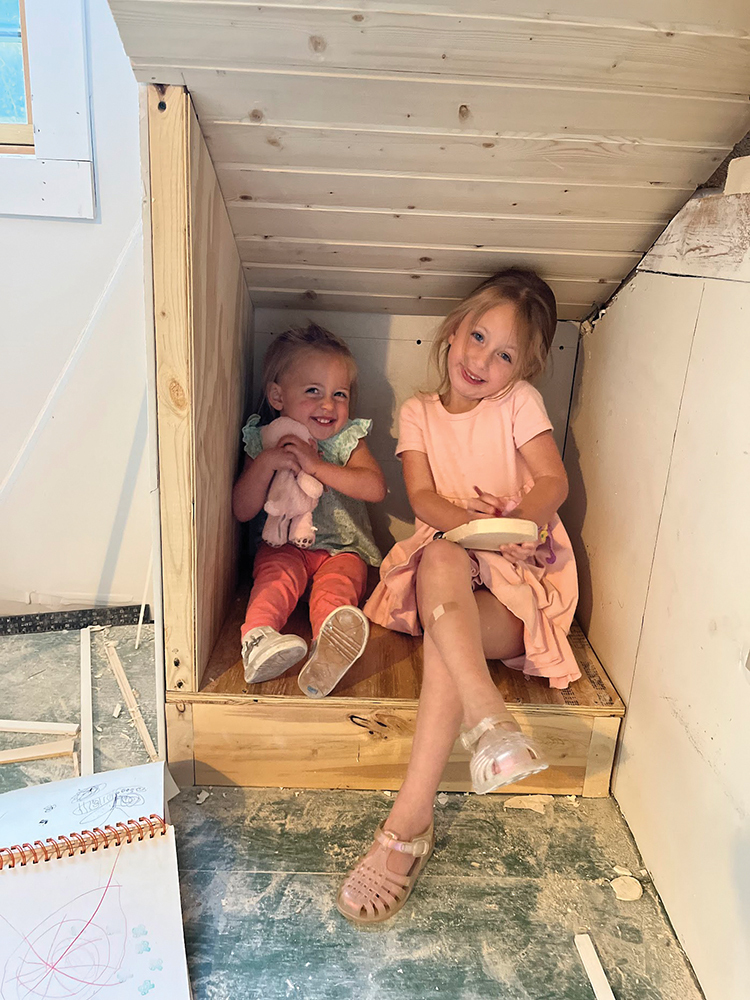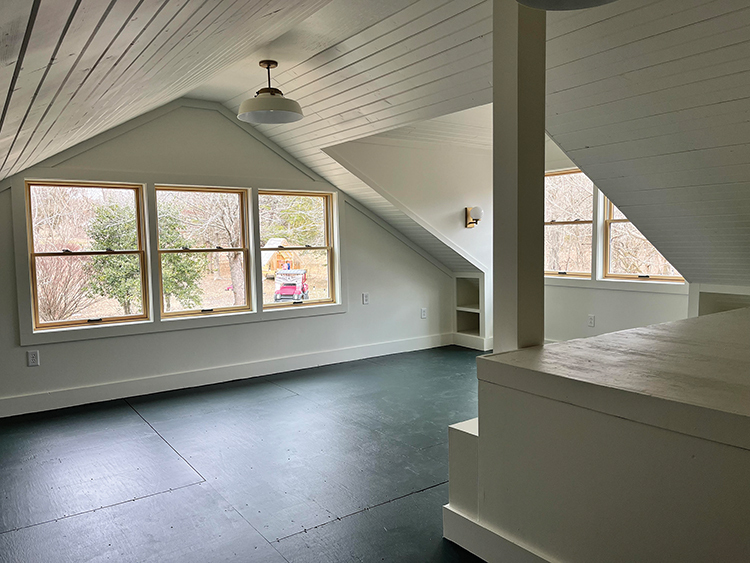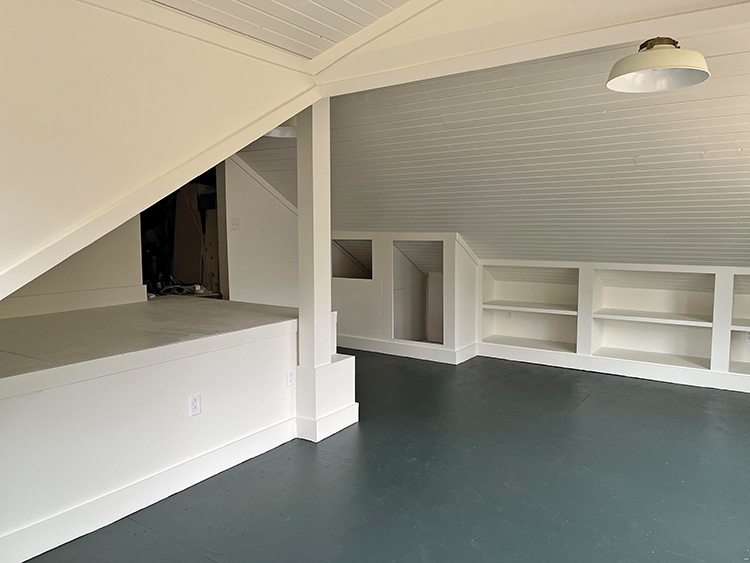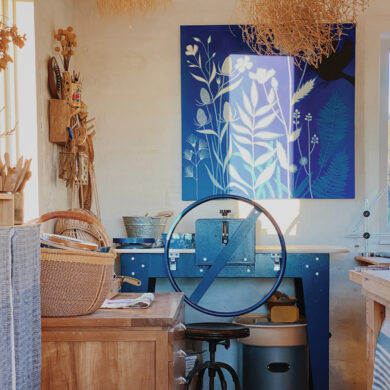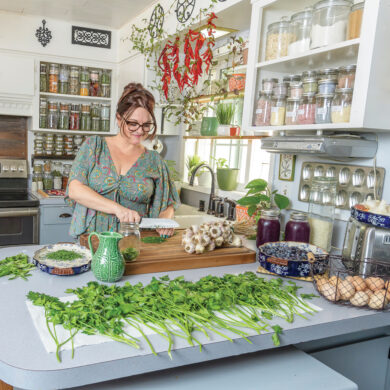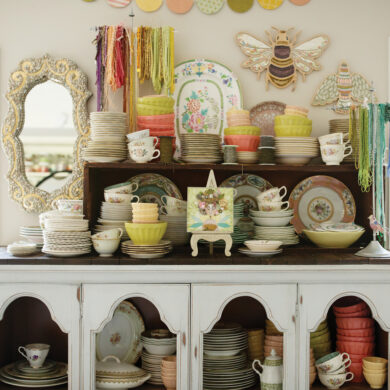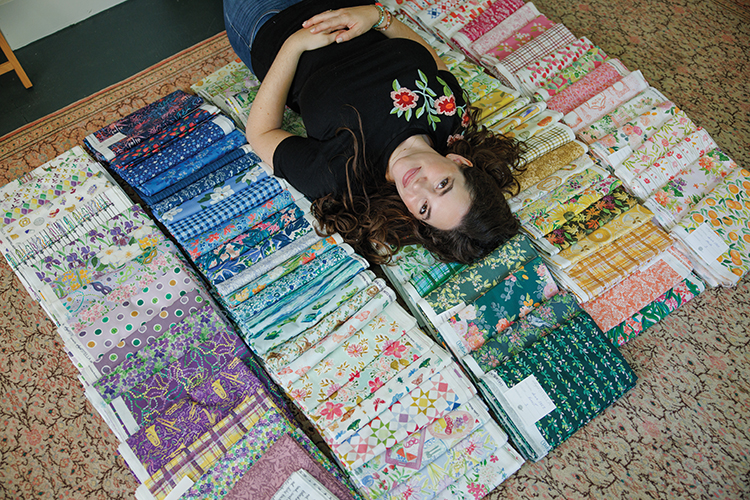
I grew up in a small, rural town in Illinois, way out in the country between farmland and forest. I spent a lot of time outside, in the creek in my backyard, surrounded by trees and flowers, herb and vegetable gardens. My grandparents lived on the same land, nearly 200 acres, just right up the road, so I spent much of my childhood with them, helping my grandmother cook, picking asparagus from my grandfather’s huge garden and doing watercolor painting at their kitchen table.
The land I grew up on, or the “family farm,” as it was known, was originally settled by my great-great-grandfather Jonathan Wallace. He and his son, my great-grandfather William, were farmers and had a peach orchard on the property. My grandfather Kestner Wallace broke the farming tradition to become a teacher and school superintendent, but later in life, he wrote two books full of tales about the family farm. At age 20, my grandfather built the house I grew up in, originally for his mother (my great-grandmother Verba) and siblings after their original home burned (the same year his father died).
My dad, Ray, moved into the house (his grandmother’s) before I was born, and my parents built onto it over the years as our family expanded. We always had chickens, but the farmland eventually turned back into forest so the “farm” mostly became trees and flowers and family stories.
I love the link between creation and creating and I always credit my childhood surrounded by nature, vibrant history and making for nurturing my creativity. Painting was my first real artistic love, but my mom is an excellent seamstress so I also grew up sewing and learning embroidery and all kinds of fiber arts. I went with her to fabric stores and had a nice fabric collection of my own, even in grade school. I only occasionally made things out of my fabric stash — I just loved the colors and patterns!
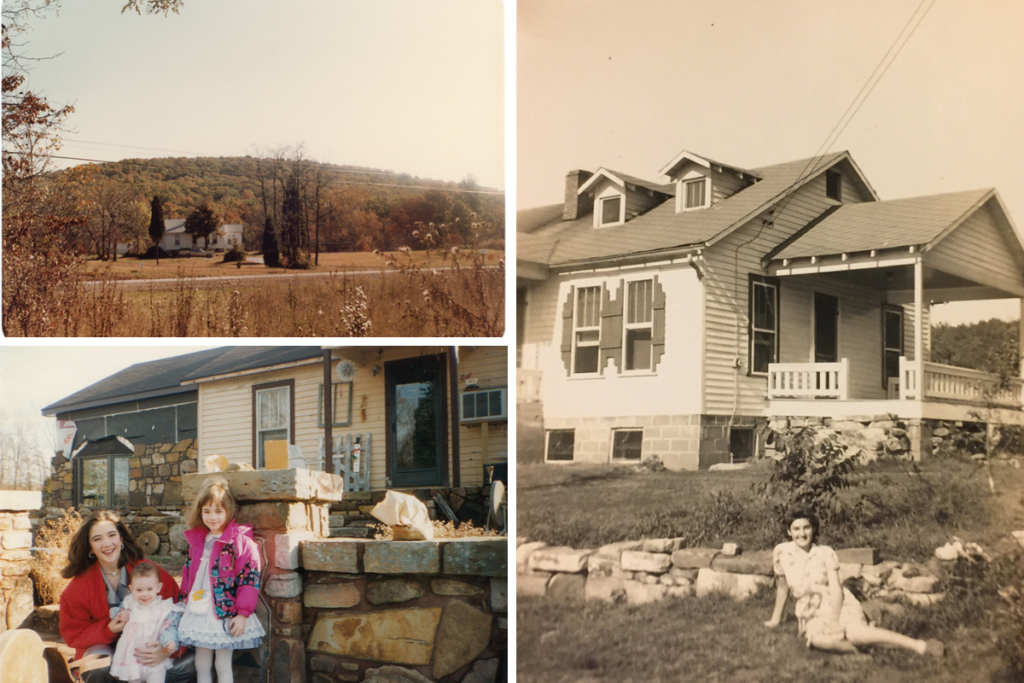
For undergrad, I got a scholarship to Tulane University in New Orleans and I ended up double majoring in English and studio art (painting). I initially thought I wanted to be a teacher like my grandparents (English, because I was inspired to tell stories like my grandfather), but while at Tulane I discovered the world of graphic design and then the world of fabric design and I immediately knew that’s what I was meant to do. Designing textiles combines the worlds of painting and digital design with my background in fibers so wonderfully. I love the idea of telling stories through art.
I worked in graphic design for a few years, learning more and more about the textile design world through in-person workshops and online courses (this was before Skillshare and the plethora of online design classes offered today) from other fabric designers that I admired: Anna Maria Horner, Heather Ross, the original designers of Cotton + Steel (now the Ruby Star Society) and Bonnie Christine Forkner. I saved up money and decided to enroll in graduate school at SCAD and there I studied more about fibers, textile and surface-pattern design, and the history of textiles. I honed my work and my painting style, and I ended up interning in the print design department at Lilly Pulitzer’s headquarters!
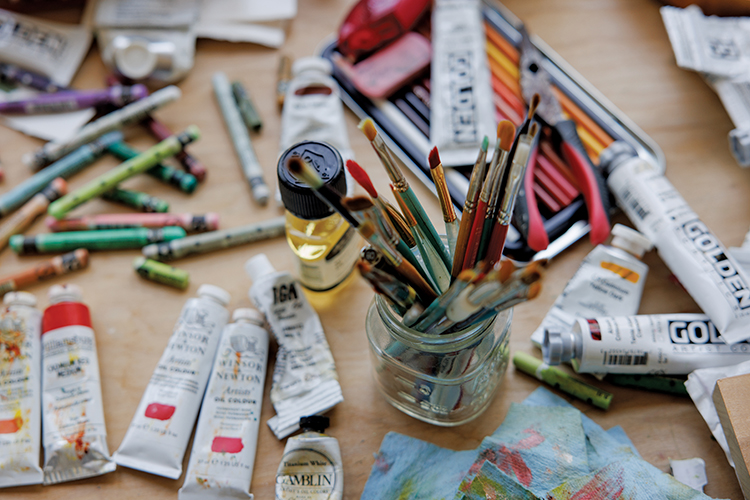
After finishing my master’s degree, I started working as a freelance fabric designer for Dear Stella Fabrics, and I’ve now produced over a dozen fabric collections with them, mostly on quilting cottons. I also license my work to other companies that use it on products. I’ve had a water bottle in Target stores; stationery, paper products and party supplies in HomeGoods/TJ Maxx stores; and some beauty products and bags at Nordstrom Rack. I’ve had my patterns on candles, calendars, clothes, quilts and home furnishings. I love being able to create beautiful things that can fill people’s everyday lives with more color, beauty and joy!
It is really meaningful to me to combine both beauty and function in my art. I also paint fine-art paintings in my studio, sell art prints of my work and produce some of my own patterned products like tea towels, tote bags, cards and notebooks.
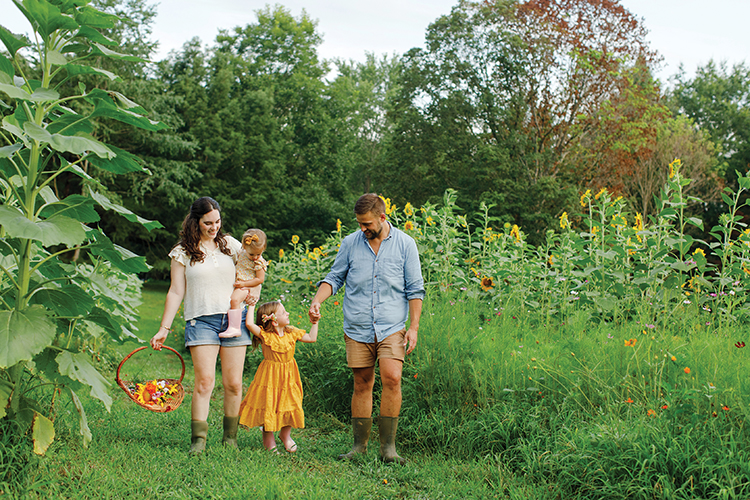
In October of 2019, when I was only 28, my dad died suddenly of pancreatic cancer (at only 62) and it completely changed my world. My husband and I had just had our first baby (our daughter Laurel); we’d just bought a house in New Orleans that we were excited to renovate and make our own; and my first fabric collection had just been released in stores — things I’d been working towards and dreaming about for years. With my dad’s death, my own dreams of what the future looked like gave way to responsibility and how to manage the family land. I had always felt a need to care for the family farm in some way, but I wasn’t prepared for it to be so soon.
My younger sisters Kelsey and Jillian took care of things for a bit without my dad around, but soon their own lives took them off in different directions (one moved to Iowa for a job and the other to Florence, Italy, for grad school).
So, my husband took a remote job, and we left our friends and life in New Orleans (that we had built over 12 years) and moved back to our hometown in Southern Illinois with our daughters Laurel and Lilla (who was only 3 months old at the time!) and back into my childhood home.
The transition from city amenities to country life has been rough at times — we miss so much about the vibrancy and creativity of New Orleans, the flowers that bloomed year-round and the celebratory attitude towards life. Farm life has a slower pace on the surface, but it is so much work to care for so much acreage. It’s special for my children (the sixth generation on this land!) to get to know and love this place like I do and to watch them grow up where I did.
The changing seasons have been good for me as an artist and remind me to look for beauty all around, despite the circumstances. We’ve added our own touches to both the house and property, re-planting the orchard and creating our own wildflower field cutting garden.
When we first moved back, my temporary studio setup was on the main floor, right off the entry/ living room in a converted old side porch. It had good lighting but was small and didn’t have adequate storage space for my art, supplies, products and shipping materials, so it always looked disheveled right when you walked into our house.
I always envisioned turning the attic storage room into a studio. … It took nearly a year of construction, but we made it happen (and did most of it ourselves)! My husband, Andrew (Drew), and I hired someone locally to come build out the dormer (I draw the DIY line at cutting holes in the roof!) and they installed the windows and patched the roofing on the outside. We hired someone else to come spray foam insulation (the room previously stayed so hot in the summer), but other than that, we did most of the work.
I cut the drywall (which took forever with all those angles) and Drew helped me hang it. We added wooden car siding (or shiplap) to the ceiling. Drew’s dad is very handy with electrical work, and he helped us run wiring for the sconces. We trimmed out all the windows, ceilings and baseboards and built storage cubbies and shelves along both sides of the room, caulked (so much caulk!) and painted.
We bought a vintage cast-iron sink off Facebook Marketplace and drove a couple of hours to Highland, Illinois, with kids in tow to cut it out of a house that was about to be torn down. I’m pretty proud of the fact that Drew and I hauled it out of the basement — it weighs like 300 pounds! It feels like it was made for that little nook of the room and is perfect for getting paint water, cleaning out brushes and having water close by to water the plants. I searched for one with a built-in drainboard and I love having that space to leave my brushes lying flat to dry.
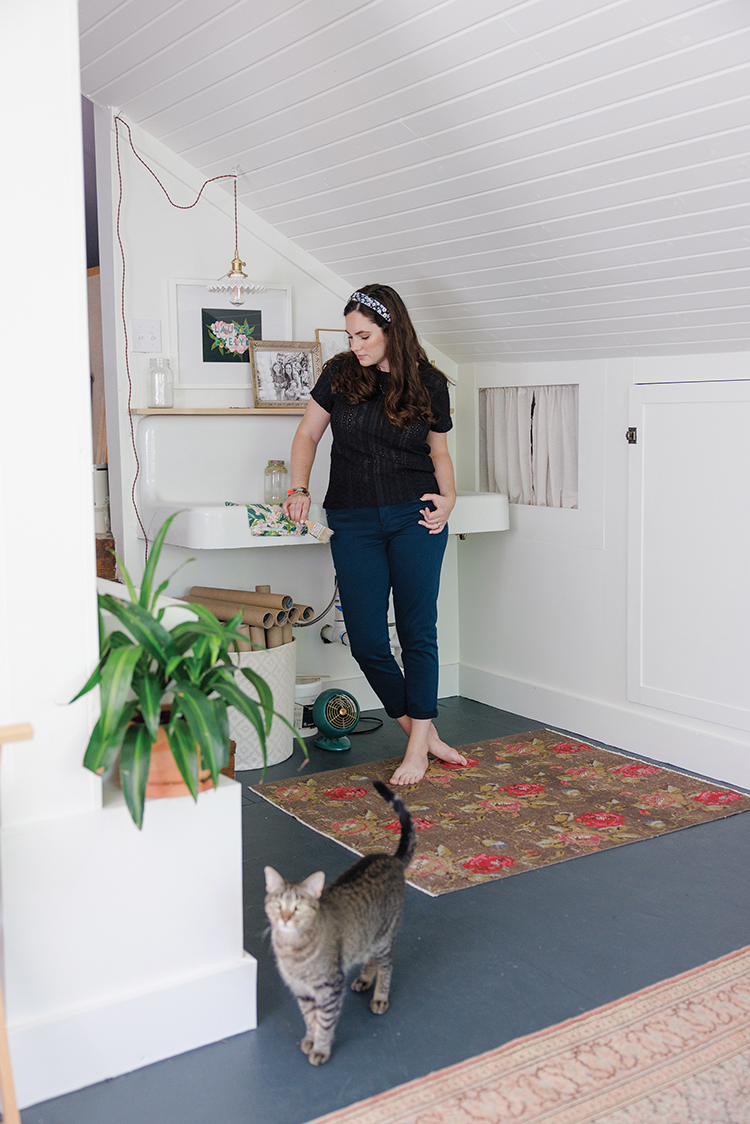
The previous room had such steeply sloped ceilings that there wasn’t a lot of head clearance, so the dormer makes such a huge difference. It had a broken attic fan that was just mesh, open to the outside, and the one window made it dark and dreary.
Now with five brand-new windows (northern and eastern light), it has beautiful sun all day! There are a couple of funky “bump outs” in the room that leave ceiling clearance for rooms below, so those had to be worked around, but they turned into nice ways to add storage cubbies and horizontal space for printing, packing and shipping products.
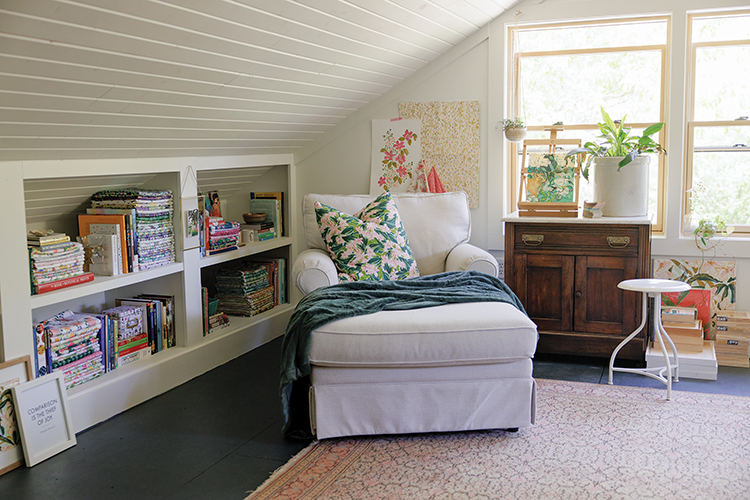
The built-in shelves we added on both sides of the room give me lots of storage for all the fabric collections I’ve designed, and art books, sketchbooks and mementos. I love having plants up here — and with all the light and views out into the forest, it feels like I’m up in a treehouse.
Part of this room was my bedroom at one point growing up, so it feels nice and cozy to be here again, albeit in a cleaner and brighter space! I LOVE the coziness of attic spaces: This really is my dream studio!
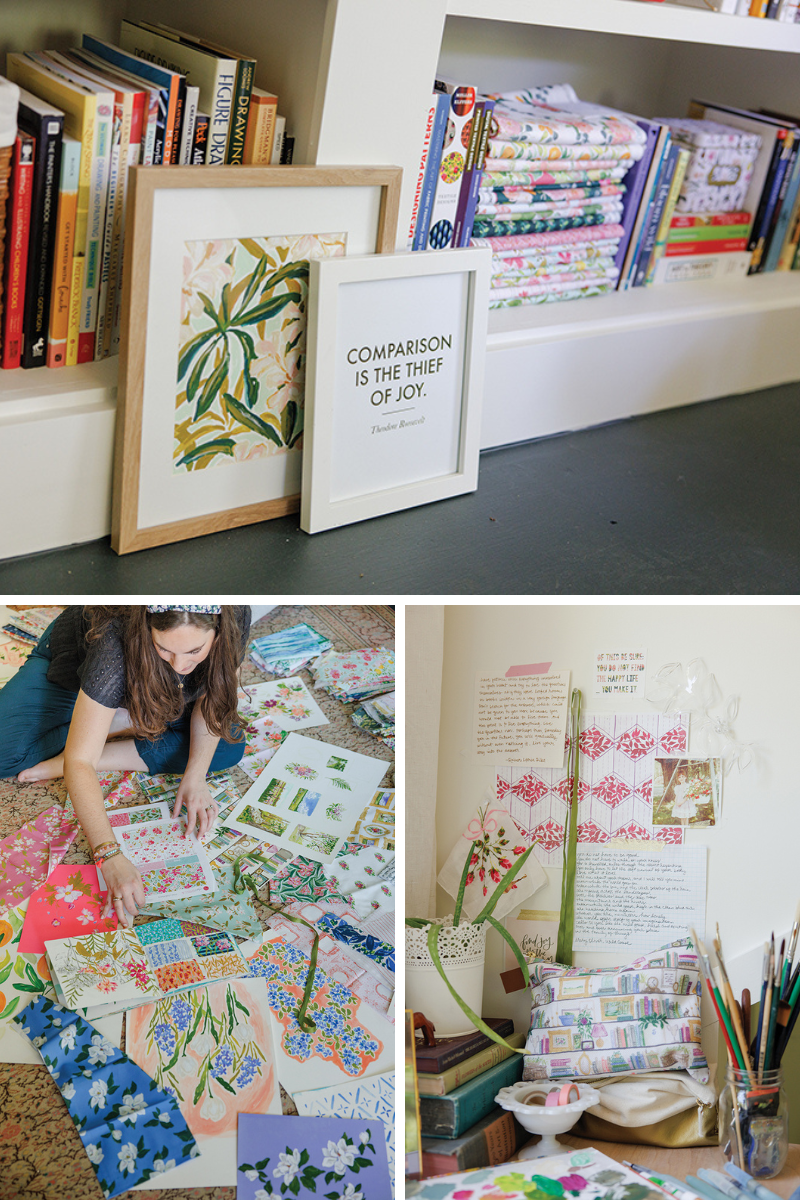
It has been really special to make our own mark on a house that has been lived in and changed by so many family hands through the generations. To know that it was loved by my great-grandmother, great-aunts and great-uncles and cousins, my grandfather, my dad, me, my siblings and my children is comforting. The responsibility of being tethered to a specific place can feel so limiting, but it is also a gift I’m incredibly grateful for.
Living here has been a constant journey through grief: grieving the loss of my dad, of my family as I knew it, of the life I had before he died, of the future I always thought we would have. It’s been a struggle to figure out what home means to me and what it feels and looks like. But being here, I keep coming back to the light and shadow through the trees at sunset — the trees my dad planted that continue to produce oxygen for me to breathe long after his last breath on this earth. It’s like he still breathes over our family land, and us, through the trees.
Each season here, I’m surrounded by flowers — rhododendrons my dad planted and cared for, irises where my great-great-grandparents’ original homeplace used to be — that continue to come up long after those who planted them have gone. Nothing lasts forever: Our lifetimes have limits, and yet legacies are carried on.
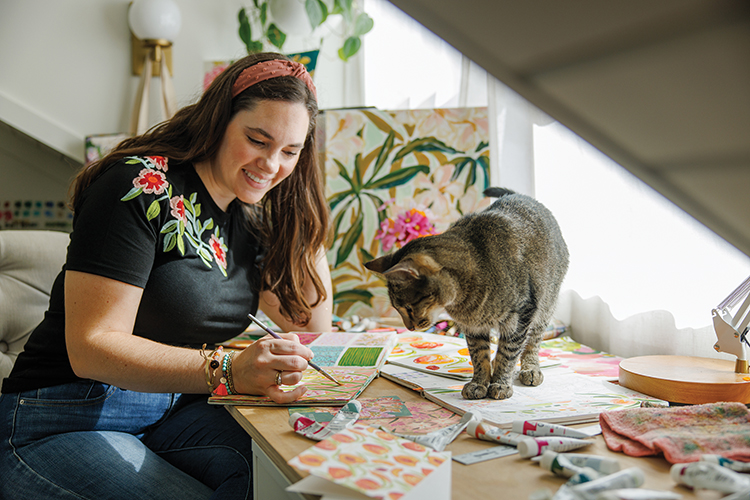
I’m so interested in the idea of legacy, especially one that isn’t about career or accomplishments or successes but simply the beauty we add to the natural world around us. And also, of the power of combined lifetimes — the ability for goodness to hold and pass through generations.
I heard once that having children is like a river that flows through you, connecting you back to your ancestors and all those who have come before. I feel like my art, especially while working from my ancestral home, has been a river flowing out of me, capturing the places I, and those before me, have dedicated our lives to maintaining.
Joy and sorrow, beauty and pain — they are always intertwined. We aren’t spared the bad, but we can choose to still see the beauty.

I grew up in a small, rural town in Illinois, way out in the country between farmland and forest. I spent a lot of time outside, in the creek in my backyard, surrounded by trees and flowers, herb and vegetable gardens. My grandparents lived on the same land, nearly 200 acres, just right up the road, so I spent much of my childhood with them, helping my grandmother cook, picking asparagus from my grandfather’s huge garden and doing watercolor painting at their kitchen table.
The land I grew up on, or the “family farm,” as it was known, was originally settled by my great-great-grandfather Jonathan Wallace. He and his son, my great-grandfather William, were farmers and had a peach orchard on the property. My grandfather Kestner Wallace broke the farming tradition to become a teacher and school superintendent, but later in life, he wrote two books full of tales about the family farm. At age 20, my grandfather built the house I grew up in, originally for his mother (my great-grandmother Verba) and siblings after their original home burned (the same year his father died).
My dad, Ray, moved into the house (his grandmother’s) before I was born, and my parents built onto it over the years as our family expanded. We always had chickens, but the farmland eventually turned back into forest so the “farm” mostly became trees and flowers and family stories.
I love the link between creation and creating and I always credit my childhood surrounded by nature, vibrant history and making for nurturing my creativity. Painting was my first real artistic love, but my mom is an excellent seamstress so I also grew up sewing and learning embroidery and all kinds of fiber arts. I went with her to fabric stores and had a nice fabric collection of my own, even in grade school. I only occasionally made things out of my fabric stash — I just loved the colors and patterns!

For undergrad, I got a scholarship to Tulane University in New Orleans and I ended up double majoring in English and studio art (painting). I initially thought I wanted to be a teacher like my grandparents (English, because I was inspired to tell stories like my grandfather), but while at Tulane I discovered the world of graphic design and then the world of fabric design and I immediately knew that’s what I was meant to do. Designing textiles combines the worlds of painting and digital design with my background in fibers so wonderfully. I love the idea of telling stories through art.
I worked in graphic design for a few years, learning more and more about the textile design world through in-person workshops and online courses (this was before Skillshare and the plethora of online design classes offered today) from other fabric designers that I admired: Anna Maria Horner, Heather Ross, the original designers of Cotton + Steel (now the Ruby Star Society) and Bonnie Christine Forkner. I saved up money and decided to enroll in graduate school at SCAD and there I studied more about fibers, textile and surface-pattern design, and the history of textiles. I honed my work and my painting style, and I ended up interning in the print design department at Lilly Pulitzer’s headquarters!

After finishing my master’s degree, I started working as a freelance fabric designer for Dear Stella Fabrics, and I’ve now produced over a dozen fabric collections with them, mostly on quilting cottons. I also license my work to other companies that use it on products. I’ve had a water bottle in Target stores; stationery, paper products and party supplies in HomeGoods/TJ Maxx stores; and some beauty products and bags at Nordstrom Rack. I’ve had my patterns on candles, calendars, clothes, quilts and home furnishings. I love being able to create beautiful things that can fill people’s everyday lives with more color, beauty and joy!
It is really meaningful to me to combine both beauty and function in my art. I also paint fine-art paintings in my studio, sell art prints of my work and produce some of my own patterned products like tea towels, tote bags, cards and notebooks.

In October of 2019, when I was only 28, my dad died suddenly of pancreatic cancer (at only 62) and it completely changed my world. My husband and I had just had our first baby (our daughter Laurel); we’d just bought a house in New Orleans that we were excited to renovate and make our own; and my first fabric collection had just been released in stores — things I’d been working towards and dreaming about for years. With my dad’s death, my own dreams of what the future looked like gave way to responsibility and how to manage the family land. I had always felt a need to care for the family farm in some way, but I wasn’t prepared for it to be so soon.
My younger sisters Kelsey and Jillian took care of things for a bit without my dad around, but soon their own lives took them off in different directions (one moved to Iowa for a job and the other to Florence, Italy, for grad school).
So, my husband took a remote job, and we left our friends and life in New Orleans (that we had built over 12 years) and moved back to our hometown in Southern Illinois with our daughters Laurel and Lilla (who was only 3 months old at the time!) and back into my childhood home.
The transition from city amenities to country life has been rough at times — we miss so much about the vibrancy and creativity of New Orleans, the flowers that bloomed year-round and the celebratory attitude towards life. Farm life has a slower pace on the surface, but it is so much work to care for so much acreage. It’s special for my children (the sixth generation on this land!) to get to know and love this place like I do and to watch them grow up where I did.
The changing seasons have been good for me as an artist and remind me to look for beauty all around, despite the circumstances. We’ve added our own touches to both the house and property, re-planting the orchard and creating our own wildflower field cutting garden.
When we first moved back, my temporary studio setup was on the main floor, right off the entry/ living room in a converted old side porch. It had good lighting but was small and didn’t have adequate storage space for my art, supplies, products and shipping materials, so it always looked disheveled right when you walked into our house.
I always envisioned turning the attic storage room into a studio. … It took nearly a year of construction, but we made it happen (and did most of it ourselves)! My husband, Andrew (Drew), and I hired someone locally to come build out the dormer (I draw the DIY line at cutting holes in the roof!) and they installed the windows and patched the roofing on the outside. We hired someone else to come spray foam insulation (the room previously stayed so hot in the summer), but other than that, we did most of the work.
I cut the drywall (which took forever with all those angles) and Drew helped me hang it. We added wooden car siding (or shiplap) to the ceiling. Drew’s dad is very handy with electrical work, and he helped us run wiring for the sconces. We trimmed out all the windows, ceilings and baseboards and built storage cubbies and shelves along both sides of the room, caulked (so much caulk!) and painted.
We bought a vintage cast-iron sink off Facebook Marketplace and drove a couple of hours to Highland, Illinois, with kids in tow to cut it out of a house that was about to be torn down. I’m pretty proud of the fact that Drew and I hauled it out of the basement — it weighs like 300 pounds! It feels like it was made for that little nook of the room and is perfect for getting paint water, cleaning out brushes and having water close by to water the plants. I searched for one with a built-in drainboard and I love having that space to leave my brushes lying flat to dry.

The previous room had such steeply sloped ceilings that there wasn’t a lot of head clearance, so the dormer makes such a huge difference. It had a broken attic fan that was just mesh, open to the outside, and the one window made it dark and dreary.
Now with five brand-new windows (northern and eastern light), it has beautiful sun all day! There are a couple of funky “bump outs” in the room that leave ceiling clearance for rooms below, so those had to be worked around, but they turned into nice ways to add storage cubbies and horizontal space for printing, packing and shipping products.

The built-in shelves we added on both sides of the room give me lots of storage for all the fabric collections I’ve designed, and art books, sketchbooks and mementos. I love having plants up here — and with all the light and views out into the forest, it feels like I’m up in a treehouse.
Part of this room was my bedroom at one point growing up, so it feels nice and cozy to be here again, albeit in a cleaner and brighter space! I LOVE the coziness of attic spaces: This really is my dream studio!

It has been really special to make our own mark on a house that has been lived in and changed by so many family hands through the generations. To know that it was loved by my great-grandmother, great-aunts and great-uncles and cousins, my grandfather, my dad, me, my siblings and my children is comforting. The responsibility of being tethered to a specific place can feel so limiting, but it is also a gift I’m incredibly grateful for.
Living here has been a constant journey through grief: grieving the loss of my dad, of my family as I knew it, of the life I had before he died, of the future I always thought we would have. It’s been a struggle to figure out what home means to me and what it feels and looks like. But being here, I keep coming back to the light and shadow through the trees at sunset — the trees my dad planted that continue to produce oxygen for me to breathe long after his last breath on this earth. It’s like he still breathes over our family land, and us, through the trees.
Each season here, I’m surrounded by flowers — rhododendrons my dad planted and cared for, irises where my great-great-grandparents’ original homeplace used to be — that continue to come up long after those who planted them have gone. Nothing lasts forever: Our lifetimes have limits, and yet legacies are carried on.

I’m so interested in the idea of legacy, especially one that isn’t about career or accomplishments or successes but simply the beauty we add to the natural world around us. And also, of the power of combined lifetimes — the ability for goodness to hold and pass through generations.
I heard once that having children is like a river that flows through you, connecting you back to your ancestors and all those who have come before. I feel like my art, especially while working from my ancestral home, has been a river flowing out of me, capturing the places I, and those before me, have dedicated our lives to maintaining.
Joy and sorrow, beauty and pain — they are always intertwined. We aren’t spared the bad, but we can choose to still see the beauty.









